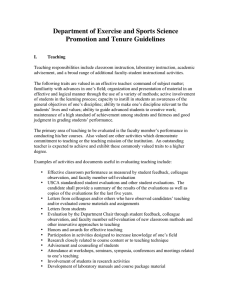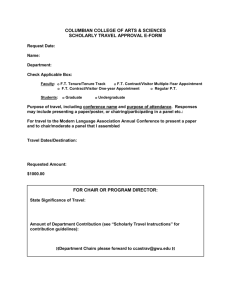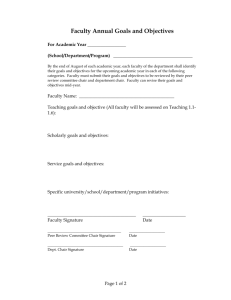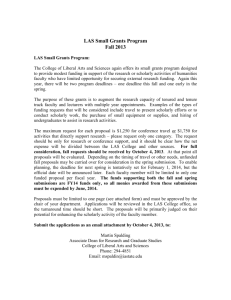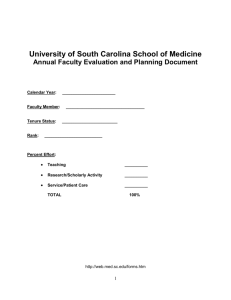Department of Exercise and Sports Science Promotion and Tenure Guidelines
advertisement
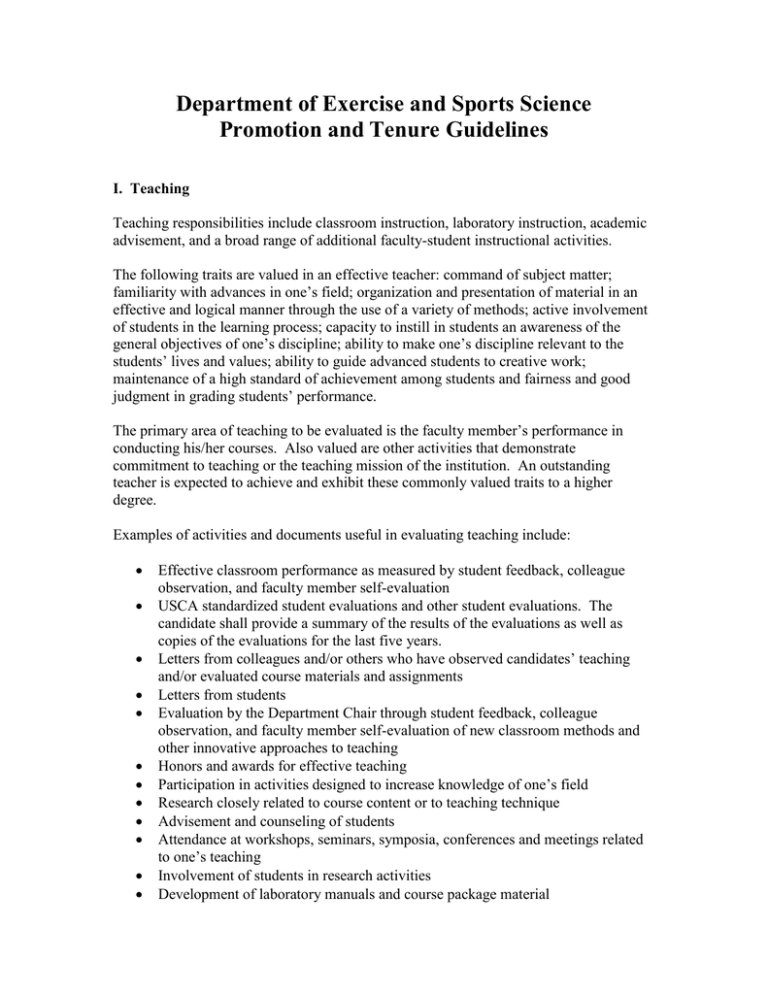
Department of Exercise and Sports Science Promotion and Tenure Guidelines I. Teaching Teaching responsibilities include classroom instruction, laboratory instruction, academic advisement, and a broad range of additional faculty-student instructional activities. The following traits are valued in an effective teacher: command of subject matter; familiarity with advances in one’s field; organization and presentation of material in an effective and logical manner through the use of a variety of methods; active involvement of students in the learning process; capacity to instill in students an awareness of the general objectives of one’s discipline; ability to make one’s discipline relevant to the students’ lives and values; ability to guide advanced students to creative work; maintenance of a high standard of achievement among students and fairness and good judgment in grading students’ performance. The primary area of teaching to be evaluated is the faculty member’s performance in conducting his/her courses. Also valued are other activities that demonstrate commitment to teaching or the teaching mission of the institution. An outstanding teacher is expected to achieve and exhibit these commonly valued traits to a higher degree. Examples of activities and documents useful in evaluating teaching include: Effective classroom performance as measured by student feedback, colleague observation, and faculty member self-evaluation USCA standardized student evaluations and other student evaluations. The candidate shall provide a summary of the results of the evaluations as well as copies of the evaluations for the last five years. Letters from colleagues and/or others who have observed candidates’ teaching and/or evaluated course materials and assignments Letters from students Evaluation by the Department Chair through student feedback, colleague observation, and faculty member self-evaluation of new classroom methods and other innovative approaches to teaching Honors and awards for effective teaching Participation in activities designed to increase knowledge of one’s field Research closely related to course content or to teaching technique Advisement and counseling of students Attendance at workshops, seminars, symposia, conferences and meetings related to one’s teaching Involvement of students in research activities Development of laboratory manuals and course package material II. Scholarly/Creative/Applied Professional Activities Scholarly/creative/applied professional activities of faculty shall be evaluated. In an institution whose primary mission is teaching, scholarly/creative/applied professional activities that enhance teaching and curriculum development shall be valued. In addition, the faculty member’s scholarly contribution in the traditional sense to his/her academic discipline, and creative activity characteristic of or related to the academic discipline shall be valued. In any endeavor, the quality of the work is more important than the quantity. As the list of examples of documentation below indicates, many kinds of scholarly/creative/applied professional activities may be valued. Strong value will be placed on research initiated and completed at USCA, research involving students, and grants that have brought funds or equipment to the Department of Exercise and Sports Science. Examples of activities and documents useful in evaluating Scholarly/Creative/Applied Professional Activities include: Refereed (using a peer review process for acceptance) professional journal articles Scholarly presentations at professional conferences, including poster sessions Written presentation of case studies in refereed professional journals Professional textbooks, chapters within a textbook, or text supplements Funded grants and submitted grants (lesser value versus those funded) Awards or prizes won for scholarship or applied professional activities Letters from colleagues from within or outside the campus who have knowledge of the candidate’s scholarly/creative work or applied professional activities Descriptions of scholarly or creative work in progress Non-peer reviewed publications III. University, Professional, and Community Service Three categories of service will be considered. The categories of service, 1) University, 2) Professional, and 3) Community, are listed in descending order of importance. For any committee, being the Chair carries more weight than being a Member. Examples of university service include: Contributions to the effective functioning of the academic department, college, and university as a whole. The specific contributions will be documented by the Department Chair and will reflect the faculty member’s participation in day-today operations. Chair/member of Faculty Assembly committee Chair/member of Faculty Assembly sub-committee Chair/member of ad hoc campus committee Chair/member of a search committee for an EXS position Chair/member of search committee for another department Chair/member of departmental committees, such as the Athletic Training Application Concentration Committee Chair/member of a departmental or university task force Examples of professional service include: Proctoring exams for the American College of Sports Medicine, the National Athletic Training Association, or other professional certification organizations Service on professional accreditation teams Service at professional conferences including chairing presentation sessions Organization of symposia, conferences, workshops Leadership positions in professional organizations Reviewer of manuscripts, textbooks, and/or grants Participation in workshops for the American College of Sports Medicine, the National Athletic Training Association, or other professional organizations Examples of community service include: Service to the community at large, when it is related to the faculty member’s field of expertise or when it promotes the mission of USCA Service to Aiken Regional Medical Centers or other hospitals Service/presentations related to one’s field to student organizations, including university groups Presentations related to one’s field to community organizations, civic groups, or local schools Service on boards, agencies, and commissions (local, state, and national) related to one’s field Membership in community groups related to one’s field Note: For Teaching, Scholarly/Creative/Applied Professional Activities, and Service, the faculty member is responsible for burden of proof and documentation. For Teaching, Scholarly/Creative/Applied Professional Activities, and Service, remuneration will neither lesson nor increase the value of such contributions in evaluating the candidate’s performance.
